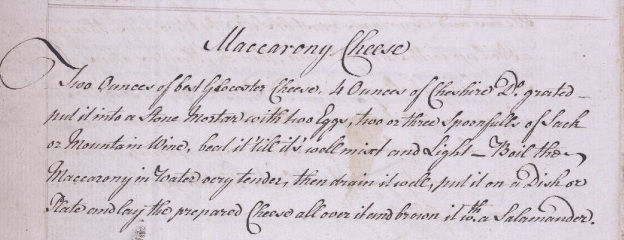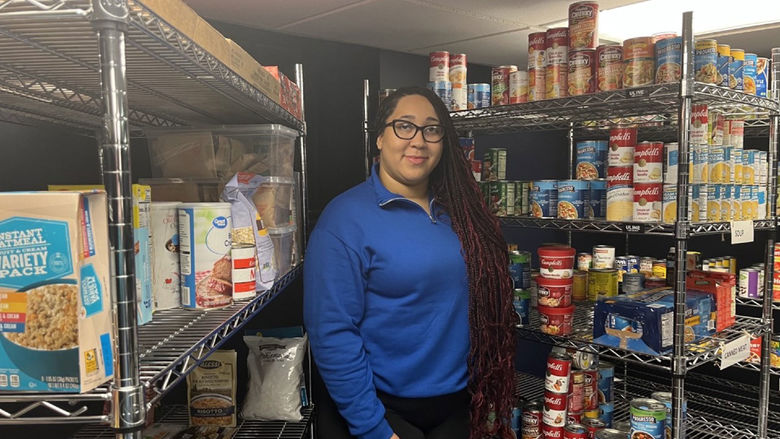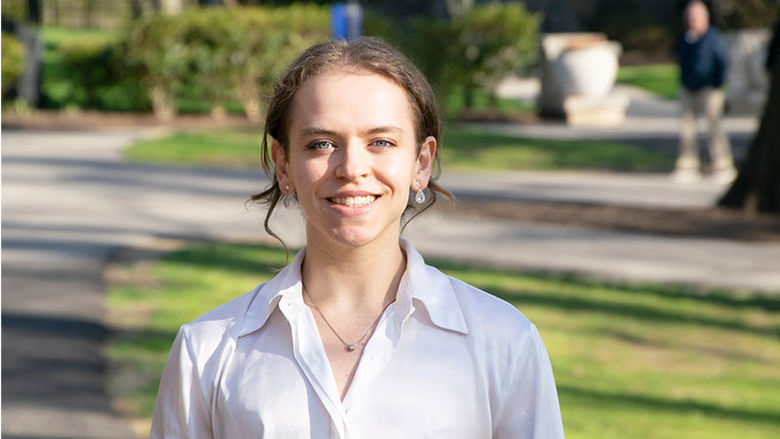

This dialog contains the full navigation menu for this site.

Often, Nicosia can be found in her kitchen blending her skills in paleography (reading historical writing) with a love for re-creating recipes dating from 1600 to 1800.
Nicosia and her graduate school pal, Alyssa Connell, decipher recipes written in the English of the time. After adjusting for instructions and ingredients they can’t replicate, they cook them with the results appearing on their blog, Cooking in the Archives: Updating Early Modern Recipes in a Modern Kitchen.
They share a passion for the Early Modern era and a commitment to deciphering recipes true to strict academic standards, but, Nicosia laughed, their cooking styles are vastly different.
“I love cooking, but it’s very slapdash. I come from a creative place,” she laughed. “Alyssa is a precision baker, and she checks and double checks recipes.”
They can frequently be found collaborating, demonstrating, and offering insight into the daily lives of women and families who lived centuries ago.
Nicosia has presented at the main Free Library of Philadelphia location, and together they have made appearances at the prestigious Folger Shakespeare Library in Washington, D.C. Their savory story also receives national media coverage.
"The household books give us a different sense of the early modern world and how people wrote and thought about their lives."
— Marissa Nicosia, assistant professor of English
In 2008, the two cooks met as doctoral candidates who needed to learn to read medieval and Renaissance research to better comb the archives for dissertation material.
“Many of the samples we used to practice came from old recipe books,” Nicosia said.
The books, primarily maintained by women, contain information in addition to recipes: births and deaths, household bills, and children’s writing.
“The household books give us a different sense of the early modern world and how people wrote and thought about their lives,” Nicosia said.
The cookbooks are housed at the University of Pennsylvania Kislak Center for Special Collections, Rare Books and Manuscripts, and were digitized in the last decade.
“Anyone can look at these resources, but it doesn't mean they’re accessible,” she said referring to the language and ingredients of the recipes, which were written as narratives. “We wanted to share these recipes to the public in a new way.”
The "new way" was fueled by by a fellowship for interdisciplinary innovation from the University of Pennsylvania graduate program — their alma mater — and the blog went live in summer 2014.
Nicosia and Connell offer readers insight into the process used and flexibility required to modernize the recipes. For example, the originals don't include time and temperature since ovens didn't exist at the time.
Nicosia said they found medicinal aids in the old recipe books, which makes sense. For centuries, cultures around the world have explored the relationship between food/spices and medicines.
"And people are re-learning that connection today," she said.
"We wanted to share these recipes to the public in a new way."
—Marissa Nicosia
Nicosia cross-references her cooking blog, which she and Connell may develop into a popular press cookbook, with her teaching at Abington.
"I try to bring in the things that I’ve learned through cooking to my students at Abington," she said. "We read Macbeth, and it talks about drugging guards with poisoned possets. A hot posset is alcohol mixed with milk and spices for colds."
The following recipe for "Maccarony Cheese" is one adapted by Nicosia and Connell.

The first recipe adapted for the Cooking in the Archives blog is comfort food, an 18th century version of macaroni and cheese.
Maccarony Cheese
Cooking in the Archives, June 2014. Recipe originated between 1765 and 1830.
Two Ounces of best Glocester Cheese, 4 Ounces Cheshire Do. grated – put it into a Stone Mortar with two Eggs, two or three Spoonfulls of Sack or Mountain Wine, beat it ’till it’s well mixt and Light – Boil the Maccarony in Water very tender, then drain it well, put it on a Dish or Plate and lay the prepared Cheese all over it and brown it with a Salamander.
This recipe features no ingredients that are mysterious, challenging to obtain, or downright unappetizing. Sack wine can be approximated. One variety later became known as sherry so sherry is what we turned to here. For Gloucester cheese, we substituted a sharp, aged cheddar; for Cheshire, a milder cheddar.
The amount of macaroni is left unspecified. Based on the amount of cheese sauce, we determined that approximately half a pound of pasta would likely have been used.
Early modern cooks used salamanders to brown dishes. A salamander was a piece of cast iron with a handle attached; it would be heated in the fire and then held on top of a dish to warm it. Essentially, a salamander was a hand-held broiler. We debated using a culinary torch but decided that an oven would provide more even cooking.
Our modern version of the recipe looked like this:
Heat oven to 350F. Grate the cheeses and beat together with eggs and sherry. Add salt and pepper to taste. Cook and drain pasta.Transfer pasta to oven-proof dish and evenly distribute cheese sauce over the top. Bake for 15-20 minutes, until cheese is melted and lightly browned.
Make your bachelor's degree more valuable by adding a minor. Earning a minor enables you to pursue a personal interest, gain specialized knowledge that complements your major, or counterbalance your major with a completely different field of study. Six business minors are available plus:
African American Studies (AFAMR)
American Studies (AMSTD)
Anthropology (ANTH)
Asian Studies (ASIA)
Biology (BIOL)
Civic and Community Engagement (CIVCM)
Communication Arts and Sciences (CAS)
Criminal Justice (CJ)
English Minor (ENGL)
History Minor (HIST)
Human Development and Family Studies (HD FS)
Information Sciences and Technology (IST)
International Studies (INSTD)
Psychology (PSY)
Religious Studies (RL ST)
Security and Risk Analysis (SRA)
Sociology Minor (SOC)
Teaching English to Speakers of Other Languages (TESOL)
Women's Studies (WMNST)
Writing (WRTNG)


